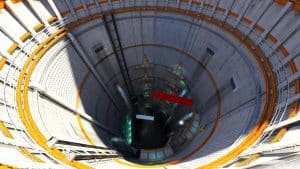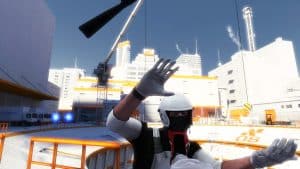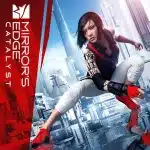Mirror’s Edge
Related apps
Description
🔥 What is Mirror’s Edge?
Mirror’s Edge is a first-person action-adventure game developed by DICE (Digital Illusions CE) and published by Electronic Arts. Mirror’s Edge revolutionized the gaming landscape by introducing first-person parkour mechanics that challenged the conventions of traditional first-person shooters. Unlike the gun-centric approach that dominated the genre at the time, Mirror’s Edge focuses entirely on movement, momentum, and traversal, creating a fresh and exhilarating experience.
The game is set in a gleaming, dystopian metropolis where a totalitarian regime controls every aspect of life, including information flow. The city’s gleaming skyscrapers, minimalistic architecture, and sterile appearance serve as a backdrop for a tense narrative that follows Faith Connors, a daring “Runner.” As a member of this underground courier network, Faith transports sensitive data while evading authoritarian surveillance and ruthless security forces. The storyline intensifies as Faith becomes embroiled in a conspiracy that threatens both her family and the delicate balance of power in the city.
Mirror’s Edge distinguishes itself through its bold visual design, minimalist storytelling, and commitment to non-linear problem-solving. By removing reliance on weapons and emphasizing the thrill of free movement, the game offers an experience of freedom and adrenaline unmatched in the genre. Over time, Mirror’s Edge has developed a cult following, influencing future game design and solidifying its legacy as one of the most innovative first-person games ever created.
👉 Features of Mirror’s Edge
First-Person Parkour Mechanics
The core of Mirror’s Edge lies in its groundbreaking first-person parkour system. Players control Faith as she performs fluid, acrobatic maneuvers like wall-running, vaulting over barriers, balancing on narrow ledges, sliding under obstacles, and chaining jumps with remarkable grace. Every move requires precision timing and an understanding of momentum, making traversal both challenging and rewarding. The first-person perspective heightens immersion, allowing players to experience every leap, stumble, and near-miss as if they were truly running across rooftops.
Unique Visual Aesthetic
Visually, Mirror’s Edge breaks away from the dark and gritty visuals often associated with dystopian settings. Instead, the game employs a striking minimalist art style dominated by pristine white buildings punctuated with bold, primary-colored highlights. This design choice serves both aesthetic and functional purposes: while it creates a clean, futuristic atmosphere, it also aids navigation by directing players towards key traversal points. The clean design heightens the sense of clarity and order, mirroring the rigid control exercised by the city’s oppressive government.
Story-Driven Campaign
The game’s narrative centers on Faith’s personal journey to uncover the truth behind her sister’s framing for murder. The tightly woven plot explores themes of governmental overreach, corruption, and resistance, all while delving into Faith’s complex relationships and personal struggles. The story unfolds through a combination of in-game cutscenes, stylized animated sequences, and subtle environmental storytelling, ensuring players remain invested throughout Faith’s high-stakes mission.
Emphasis on Non-Lethal Gameplay
While combat exists, Mirror’s Edge actively encourages players to avoid it. Faith can disarm enemies or engage in brief hand-to-hand combat, but the emphasis remains on evasion and speed. This design choice reinforces the game’s central philosophy of movement and survival through agility rather than brute force. Combat often disrupts momentum, making evasion the more strategic and satisfying option for experienced players.
Time Trial and Speedrun Modes
Beyond the main campaign, Mirror’s Edge offers additional content that extends replayability. Time Trial and Speedrun modes challenge players to perfect their routes through levels, optimizing every jump and movement to achieve the fastest times possible. These modes have fostered a passionate speedrunning community that continues to dissect the game’s mechanics and discover new shortcuts years after its release.
Minimal HUD for Maximum Immersion
The game’s interface design emphasizes immersion by stripping away traditional heads-up displays. Instead of cluttering the screen with icons and meters, players rely on subtle environmental cues and body awareness to navigate. This minimalist approach allows for a more intimate connection with Faith’s physicality and the surrounding world.
Runner Vision System
The innovative Runner Vision system highlights key environmental objects in red, guiding players towards the most efficient traversal routes. This feature allows players to intuitively identify interactive elements such as ledges, pipes, and doors without breaking immersion or resorting to intrusive waypoints.
Gameplay
Mirror’s Edge delivers a fast-paced, kinetic gameplay experience that constantly challenges players to maintain momentum, analyze environments, and execute precise sequences.
Flow and Momentum
The game’s unique “flow” mechanic revolves around maintaining constant movement. Chaining actions like wall runs, vaults, and rolls together ensures that Faith preserves speed and navigates obstacles fluidly. Losing momentum not only affects traversal but can also leave players vulnerable to enemies and environmental hazards, adding an extra layer of tension to every move.
Learning the Environment
Each level serves as a complex vertical playground filled with multiple pathways and potential shortcuts. Players are encouraged to explore different routes, developing their own preferred paths based on skill level and playstyle. This element of choice and discovery fosters a sense of ownership and creativity, allowing for highly personalized gameplay experiences.
Combat as a Last Resort
While Faith can engage in combat, doing so often breaks the flow and slows progress. Hand-to-hand fights, disarms, and limited weapon usage are available, but they serve more as tools of last resort than primary gameplay elements. The game rewards players who avoid conflict, emphasizing clever maneuvering and evasion over direct confrontation.
Trial-and-Error Mastery
The learning curve in Mirror’s Edge can be steep. Early runs may involve frequent falls and mistimed jumps, but the game’s forgiving checkpoint system encourages experimentation and gradual mastery. As players improve, they develop a deeper understanding of timing, momentum, and environmental awareness, transforming challenging sequences into seamless runs.
Speedrunning Potential
Thanks to its precise controls and open level design, Mirror’s Edge has become a staple in the speedrunning community. Expert players continuously seek to optimize their routes, discovering advanced techniques such as bunny hopping, corner boosting, and momentum preservation that allow for record-breaking runs.
Simple Controls, Complex Mastery
The game employs a streamlined control scheme assigning one button to upward actions (jumping, wall running) and another to downward actions (sliding, rolling). This simplicity allows players to focus on execution and timing while still offering a surprising depth of mastery for those willing to refine their skills.
Expanded Replayability Through Player Challenges
In addition to official modes, the community has developed its own challenges, such as no-damage runs, combatless runs, or custom route challenges. These player-generated objectives continue to breathe life into the game and extend its longevity far beyond the original campaign.
Graphics of Mirror’s Edge
Clean, Stylized Environments
The stark contrast between white urban structures and brightly colored accents creates an instantly recognizable world. The clean architecture emphasizes minimalism, offering a sleek and futuristic cityscape that feels both beautiful and unsettling in its sterile perfection.
High Contrast for Navigation
Runner Vision’s high-contrast design guides players organically. By highlighting interactive objects in red, the game subtly integrates navigation tools into the visual environment, eliminating the need for intrusive indicators or maps.
Fluid Animation
Faith’s animations are remarkably fluid, capturing the physicality of every movement. Subtle details—like her hands reaching out to steady herself, her breathing quickening after long runs, and realistic momentum shifts—heighten the sense of embodiment and immersion.
Dynamic Lighting and Reflections
The game’s lighting system enhances realism, with sunlight reflecting off glass and metal surfaces. As players navigate the city, the interplay of light and shadow contributes to the city’s sterile yet visually captivating atmosphere.
Consistent Performance
Even upon release, Mirror’s Edge was praised for its technical stability. Maintaining a consistent frame rate is crucial for a game reliant on precision timing, and the game’s performance across platforms ensured that players could fully immerse themselves in its kinetic world.
Lasting Visual Influence
Mirror’s Edge‘s unique art direction has left a lasting impression on the gaming industry. Its clean, minimalist design has inspired numerous other games, showcasing the power of visual clarity paired with functional design.
Pros and Cons
✔️ Pros
- Innovative First-Person Parkour: Redefines movement in the first-person genre.
- Distinct Visual Style: Clean, minimalist aesthetic that doubles as functional navigation aid.
- Engaging Storyline: Emotional, character-driven narrative set against a dystopian backdrop.
- Highly Replayable: Multiple routes, time trials, and speedrunning potential keep players engaged.
- Minimal HUD: Enhances immersion by removing intrusive visual elements.
- Smooth Performance: Consistent frame rates critical for responsive parkour mechanics.
- Community Longevity: Ongoing speedrunning and custom challenges keep the game relevant.
❌ Cons
- Steep Learning Curve: Mastering the complex movement system takes time.
- Short Campaign: Main story can be completed quickly for experienced players.
- Combat Feels Clunky: Combat mechanics lack the polish of traversal elements.
- Linear Level Design: Some may find the lack of open-world exploration limiting.
ℹ️ Game information
⭐ Installation Instructions
- The game is fully complete, you just need to install it, so there is no need to unpack it or download it from other sources.
- Just run the Mirror’s Edge.exe installation file.
- Simply launch the game from shortcut desktop.
⚙️ System Requirements
✅ Minimum:
- OS: Windows XP/Vista
- Processor: Intel Core i5-1300F
- Memory: 1 GB RAM
- Graphics: NVIDIA GeForce 6800
- DirectX: Version 9.0c
- Network: Broadband Internet connection
- Storage: 8 GB available space
Video
Images










